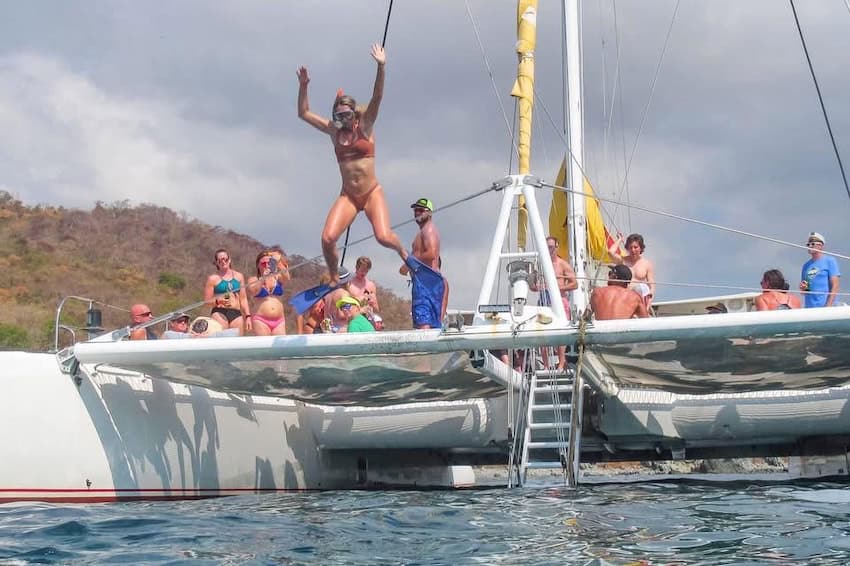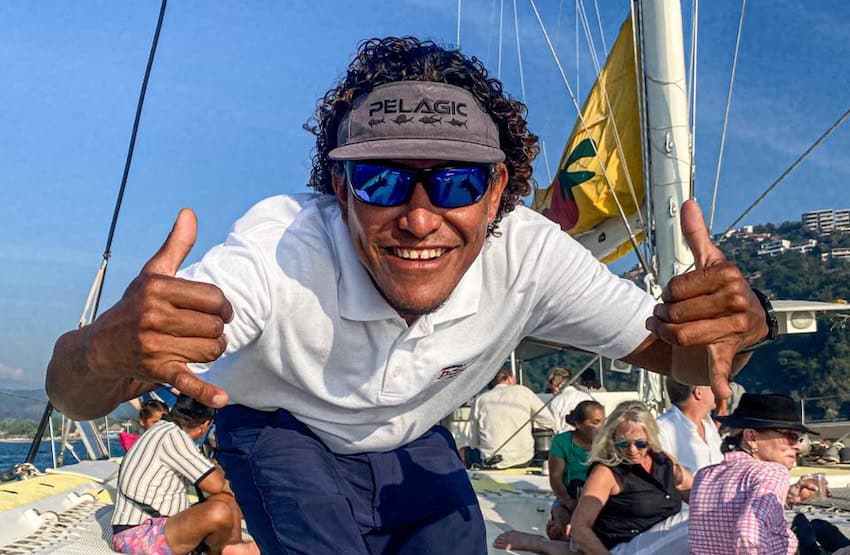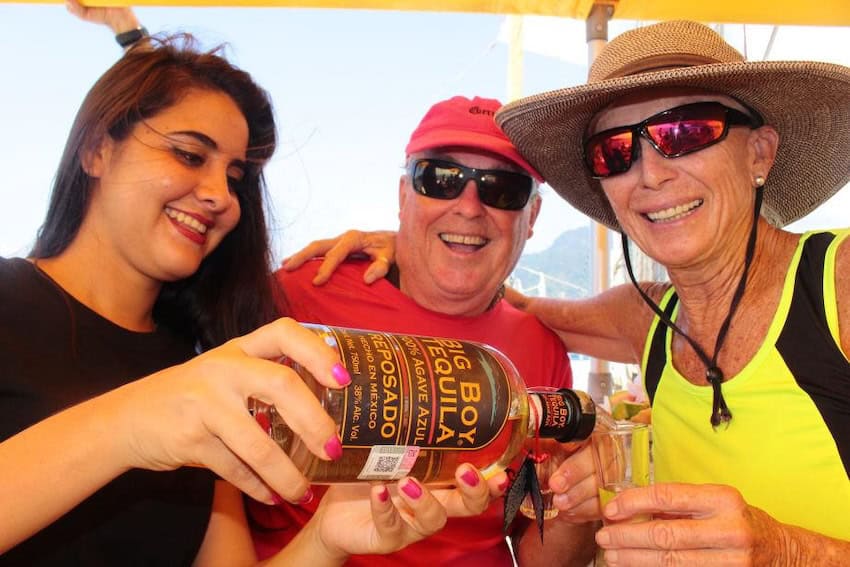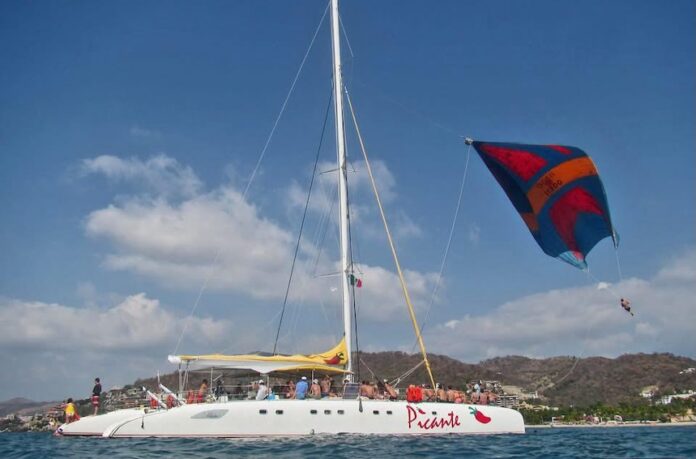Sailing into the sunset is appealing to many people and is often on the must-do list of adventures to experience while in Mexico. In Zihuatanejo, The Picante — a Fountaine Pajot Tahiti to those in the know — is a 75-foot sailing catamaran with a mast height over the water of over 100′. Built specifically for the day charter business, it is the perfect choice for the adventurous sea lover.
It all began when the late Captain Tony Piazza and his wife Claire came to Zihuatanejo at the urgings of Apple Vacations, with whom they had a business arrangement to sail charters in Cancun from 1985. The tour company assured them that this part of Mexico was the place to be, given its location, beautiful waters and little competition. But it wasn’t all smooth sailing.

Despite the setbacks, the Piazzas persevered. Their first boat in Zihuatanejo was The Tristar, and they partnered with three others. The cockpit caught on fire, setting them back until Piazza, a shipbuilder, rebuilt it a few weeks later. In 2001, they made an agreement with the owners of another boat, the Vitava, an 85-foot wooden schooner until 2004. After doing maintenance in Mazatlan, they realized it was taking on water. Since it needed further repairs, the owner returned it to the shipyard, and the Piazzas searched for another boat to continue.
Their last purchase was The Picante, which Piazza and three partners bought in the Caribbean in 2004, sailing through the Panama Canal to Zihuatanejo, where it sits today.
With the passing of Tony Piazza in April 2023, Claire was in the unenviable position of deciding whether to continue with the business. Luckily for the thousands of tourists and locals alike, she decided to keep going and, with a great team beside her, has been running it ever since.
Our sunset cruise started at 5 p.m., when we met on the pier across the bay from the main beach where the boat docks. You can see it nearly everywhere on Playa Municipal, the main beach in downtown Zihuatanejo.
It was a lively crowd that day, with a mixture of foreigners and Mexican tourists. One young woman was celebrating her birthday with a fairly large group of friends, and there were a couple of local families I recognized as well. Our captain, Carlos Ríos, welcomed everyone on board, and as we puttered out from shore, he went over the customary safety guidelines. I chose to sit on the comfortable net where I could be on the lookout for sea life.

As we left the bay, Rios pointed out Bara de Potosi and the white Islands of Potosi — white because of bird poop — and spoke about the bird-watching sanctuary located there and began an interesting narrative starting from the rim of the bay at the Faro Viaje, one of two lighthouses we would see. As the high investment in Punta Garrobo’s development came into view, he mentioned the infamous Kau Kan Restaurant, which had moved there from Ixtapa a few years ago.
The Picante headed west now towards Ixtapa, passing by a beautiful beach known as Playa Majahua and the Caves of the Majahua. Luckily, the sea was calm this evening, and we could slow the engines, sit back, and admire the cliffs. “Otherwise,” Rios said, “It’s too risky and we could get sucked into the rocks.”
From there, we crossed in front of Playa Palmar, which has numerous rows of hotels, including The Fontan, Sunscape, and Barcelo, and residential complexes like the BVG, which have stood for many years. Just past that was the Ixtapa Marina, a 480-slip marina, the largest in Mexico and home to the yacht of billionaire Carlos Slim, Mexico’s richest man.
The sun began a slow but spectacular descent to the music of Andres Botticelli’s “Perfect Symphony.” As the rays dipped below the horizon, to appreciative cheers from everyone aboard, the energetic and very entertaining staff sprang into action, offering a meal service consisting of a light dinner of chicken, vegetables and rice, included in the price, along with an open bar serving a variety of drinks, including local tequila and cocktails.
The Picante quickly turned inside the Bay of Ixtapa and headed straight to the islands. It was a bird watcher’s delight. Various species of seagulls, pelicans, Boobies, and Cormorants swooped in and around Torrecillas Island and where we were able to witness the phenomenon of one of two blow holes in Mexico (a blow hole, I learned, is formed as sea caves grow landward and upward into a vertical shaft, which can result in hydraulic compression of seawater that then releases through a port from the top of the blowhole).
With food service out of the way, the ever-changing music changed to upbeat Latin pop and requisite tequila bottles. With the help of the fun-loving crew, the sombreros and serapes appeared, and soon, the crew was pouring tequila straight from the bottle into the open mouths of willing participants and encouraged by onlookers to chant, “drink, drink drink!” The music, the costumes donned by the staff and the tequila all added to the festive atmosphere of the cruise.

“We want to make sure you have a great time on The Picante, “said Rios. “So, after the sunset we create the fiesta. If you have a birthday or an anniversary, we want to make sure it is a special experience for you.”
In addition to the breathtaking sunset tours, The Picante also offers snorkelling and whale-watching tours. For added excitement, you can try their Spinnaker Flying Adventure, a unique experience where you get into a harness connected to an A-line. The wind catches it, and the spinnaker fills up with wind and pulls you up about 25 to 30 feet high. When you want to come down, you shimmy to the end of the line to a waiting crew in the water below. It’s an adventure that’s sure to get your heart racing!
The Picante offers several other options of interest. With the advantage of size, the Picante, is perfect for private charters for weddings, engagements or corporate events.
“It has been used by the city of Zihuatanejo for promotional events and even rented by people spreading the ashes of loved ones.” said Piazza. “We participate in two of the city’s known charity events as well, the annual Sailfest and Guitarfest held annually in Zihuatanejo in the months of February and March respectively.”
The writer divides her time between Canada and Zihuatanejo.
